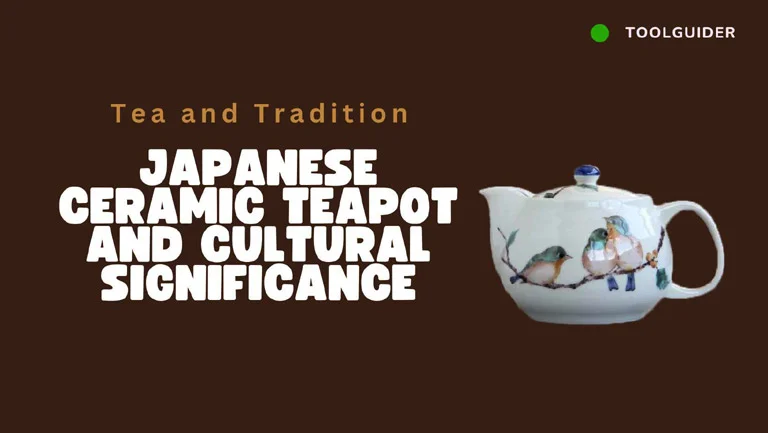
japanese ceramic teapot
Japanese ceramic teapots are known for their perfect fusion of form and function. They are meticulously crafted to provide a delightful tea-drinking experience while showcasing the artistry of their creators.
These teapots are deeply intertwined with the practice of tea ceremonies, an age-old tradition that represents mindfulness, respect, and the appreciation of beauty. Owning a Japanese teapot means embracing a piece of this heritage and showing respect to the centuries of tradition that have shaped it.
Japanese ceramic teapots, known as Kyusu, are more than just vessels for brewing tea. They are exquisite works of art that combine functional design with meticulous craftsmanship.
The glazes used on Japanese ceramic teapots serve both functional and aesthetic purposes. They can affect the teapot’s heat retention, resistance to staining, and appearance. Some teapots feature matte finishes, while others have glossy, glass-like glazes.
Japanese ceramic teapots are renowned for their intricate and thoughtful designs. These designs can range from minimalist and modern to traditional and ornate. They often incorporate nature-inspired motifs, geometric patterns, or depictions of cultural elements like cherry blossoms, dragons, or cranes.
The ergonomic design of the handle and spout in Japanese ceramic teapots is a testament to the attention to detail. The handle is crafted for comfortable pouring, while the spout is engineered to minimize drips and ensure a controlled flow of tea.
Japanese ceramic teapots will show you artistic traditions, reflecting the country’s rich cultural heritage. The artistry involved in crafting these teapots is a testament to the meticulous skills passed down through generations of artisans.
Japanese ceramic teapot is a combination of fine materials and artistic craftsmanship. They showcase the beauty of nature, culture, and tradition, while their functionality ensures a perfect brew of Japanese green tea. These teapots are more than mere utensils; they are a testament to the artistry and culture of Japan, elevating the act of tea-drinking to an exquisite experience.
Before you start your search, consider the types of tea you enjoy. Different teas may require different teapot features, such as a specific shape or built-in strainers. For example, if you primarily drink green tea, look for a Kyusu designed for that purpose.
Japanese teapot set come in various materials, such as porcelain, stoneware, and earthenware. Each has its unique characteristics, including heat retention and appearance. Reading reviews and seeking recommendations can be helpful. High-quality glazes should be food-safe and free from lead or harmful substances.
If you prefer loose-leaf tea, consider a Kyusu with a built-in strainer or removable filter. Evaluate the handle and spout for ergonomic design, ensuring ease of use and pouring control. Examine the glaze and finish of the teapot. Ensure that it is smooth, even, and free from defects.
Your chosen Japanese Ceramic Teapot will become a cherished companion for your tea-drinking journey, enhancing the experience with every brew. If possible, visit specialty tea stores or artisan markets where you can physically examine and handle various teapots. This experience will make you appreciate the craftsmanship and find the perfect teapot.
Try to buy from reputable sources that offer authentic information about the teapot’s origin, materials, and craftsmanship. Ensure that the seller values quality and authenticity.
A Japanese teapot is commonly called a “Kyusu.” It is a traditional teapot specifically designed for brewing Japanese green tea. These teapots are known for their uncommon design and functionality which makes them perfect for steeping and serving various types of green tea.
Ceramic is a great option for brewing and serving tea, enhancing your tea-drinking experience. It will distribute heat evenly throughout the teapot, ensuring tea leaves are steeped uniformly. This results in a more consistent and flavorful brew.
Porcelain and ceramic both have their share of good and bad qualities. Heat retention of porcelain is more than that of ceramic. On the other hand, ceramic happens to be more durable than porcelain. Ultimately, it comes down to personal preference that what kind of qualities you want in your teapot.
Ceramic teapots are generally safe for brewing and serving tea. When purchasing a ceramic teapot, opt for products from reputable brands or artisans who prioritize food safety and quality standards.
Ceramic teapots can be safe for tea as long as they are made with food-safe glazes, maintained properly, and inspected for damage regularly. Choosing a reputable product and following proper care guidelines will help ensure the safety of your tea when using a ceramic teapot.
Ceramic is sensitive to extreme temperature changes. If you Place a ceramic kettle directly on a hot stove it will cause thermal shock leading to cracking or even shattering of the kettle. But if the ceramic kettle is labeled as safe for direct heat, you can use it on a gas or electric stove. However, remember to follow the manufacturer’s instructions and use it with caution to prevent damage.
I love all things tech, and I wear many hats – tech lover, business starter, digital marketer, and blogger. I know the ins and outs of Digital Marketing, SEO, SEM, SMM, and how to generate leads. My goal? Making things simple for you with clear guides and reviews. I stumbled upon WordPress while creating my first business site, and I fell in love with it right away. When I’m not building websites, creating content, or boosting clients’ online efforts, I’m focused on staying healthy, hanging out with family, and exploring the world. Connect with me on Facebook, Twitter, Linkedin, or read my complete biography.
Handmade cutting boards are available in a spectrum of styles from rustic and traditional to…
Pulse jet baghouse technology represents a significant advancement in industrial air pollution control systems. This article…
What is the difficulty of in-between purchases? Say you want a guitar. This might be…
How to find the best marble cutting boards? Marble cutting boards are manufactured with the…
A butcher block cutting board is traditionally used in butcher shops and kitchens for chopping…
Choosing fish filleting machines is one of the most important tasks for your business. Cleaning…